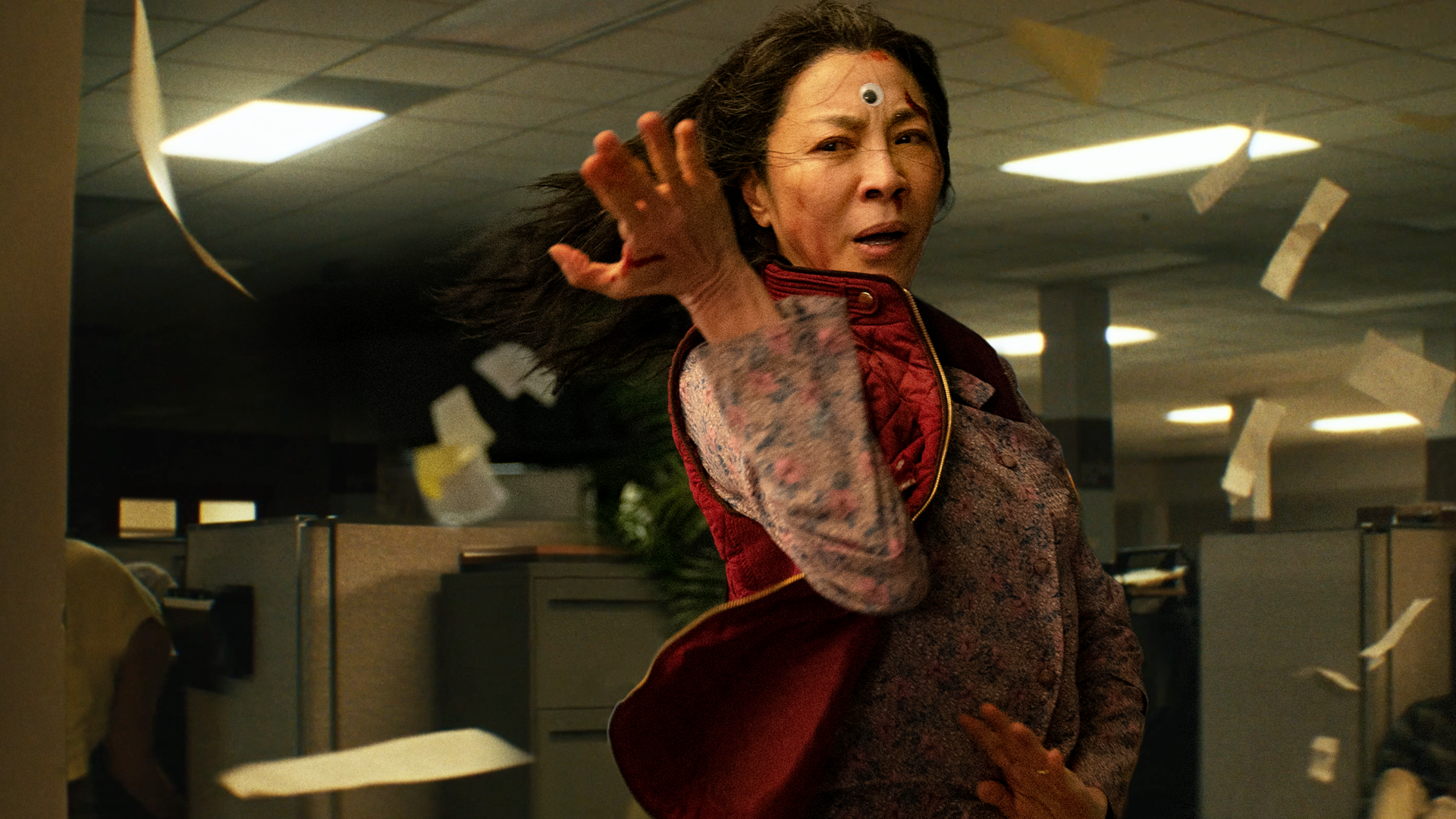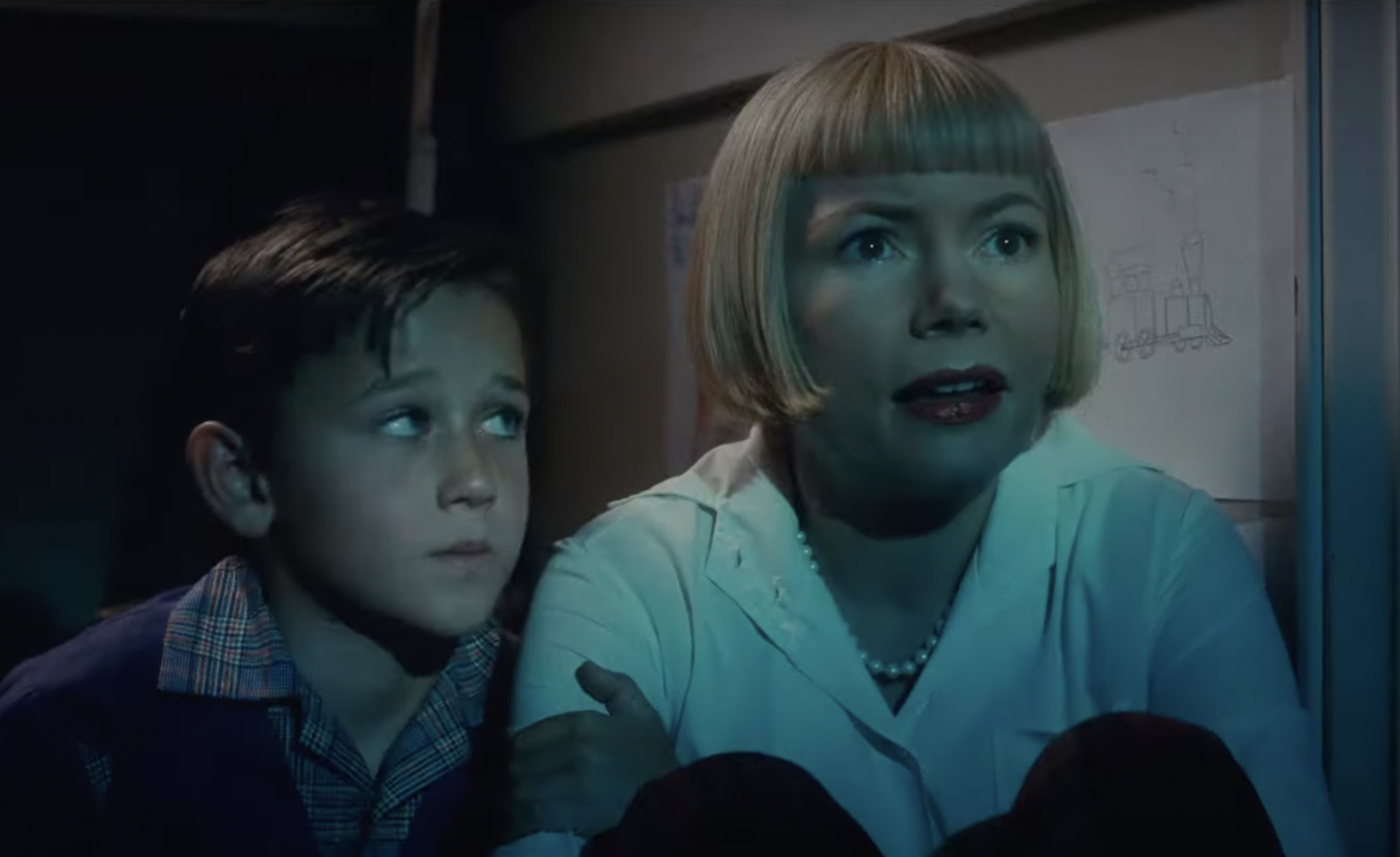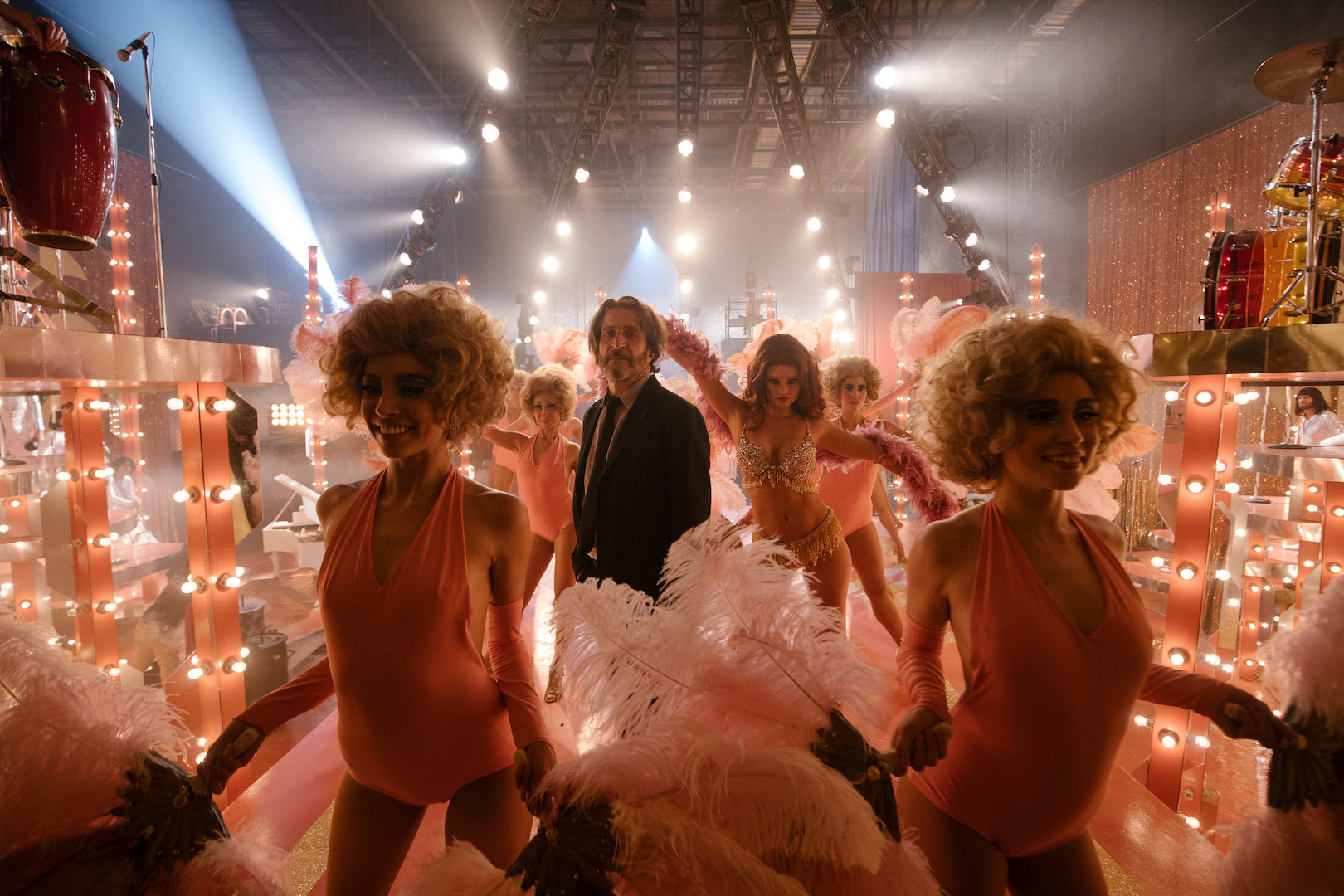Like cinematography and sound, the early leader in the editing race is Joseph Kosinski’s high-octane “Top Gun: Maverick” (Paramount), where we’re put inside the cockpit with Tom Cruise during the amazing dogfights. But in a season marked by stories of showbiz, social change, and superheroics, there are plenty of outstanding contenders that display creative and bold rhythm and pacing.
Among the other early frontrunners are the Daniels’ complex multiverse of “Everything Everywhere All at Once” (A24); Jordan Peele’s flipped-out sci-fi/horror spectacle, “Nope” (Universal); Brett Morgen’s mind-blowing David Bowie documentary, “Moonage Daydream” (Neon); and Baz Luhrmann’s delirious biopic, “Elvis” (Warner Bros.).
However, the festival season brought forth Steven Spielberg’s TIFF-winning, semi-autobiographical “The Fabelmans” (Universal); Sam Mendes’ wistful ode to the cinema in “Empire of Light” (Searchlight Pictures); Sarah Polley’s thought-provoking “Women Talking” (UA); James Gray’s semi-autobiographical “Armageddon Time” (Focus Features); Martin McDonagh’s black comedy about a turbulent bromance, “The Banshees of Inisherin (Searchlight); Todd Field’s psychological drama, “TÁR” (Focus Features); and Ruben Östlund’s Palme d’Or-winning social satire,”Triangle of Sadness” (Neon).
Other contenders include Damien Chazelle’s epic of Hollywood debauchery, “Babylon” (Paramount); Gina Prince-Bythewood’s rousing “The Woman King” (Sony); Alejandro González Iñárritu’s introspective “Bardo” (Netflix); Andrew Dominik’s impressionistic “Blonde” (Netflix); and David O. Russell’s black comedy “Amsterdam” (20th Century).
For those wondering about Best Editing as a barometer for predicting Best Picture, they’ve only aligned once in the last decade, with “Argo” in 2012.

“Everything Everywhere All at Once”
Allyson Riggs/A24
Creating the Spectacle
The daredevil thrill ride of “Top Gun: Maverick” was made possible by the innovative Sony Rialto Camera Extension System overseen by cinematographer Claudio Miranda , which fit six 6K Venice cameras inside the cockpits. With more than 813 hours of aerial footage for editor Eddie Hamilton to assemble and cut, it became a complex puzzle to construct. Initially, he cut only interior shots of the pilots, using model F-18s on wooden sticks recorded on iPhones to give an idea of exterior jet shots. Months later the exterior shots were combined to make the action play effortlessly, kinetically, and emotionally. But it was important to win the viewers over within the first two minutes, which meant the opening carrier deck montage was critically important to set the stage for the return of Cruise’s Maverick.
Cracking the genre-bending “Everything Everywhere All at Once” for editor Paul Rogers was about finding the emotional connection between stressed out mother Evelyn (Michelle Yeoh) and her joyless daughter, Joy (Stephanie Hsu), who become combatants in this maximalist kung-fu epic. The bombastic editing and the crazy aesthetic choices were carefully layered onto the central arc by the editor and the directing duo of Dan Kwan and Daniel Scheinert. Where the freeform and experimentation came in was during the jumping between exotic and mundane universes.
Peele tapped go-to editor Nicholas Monsour for “Nope,” his re-imagining of the UFO film as a cautionary tale about spectacle. The challenge for Monsour was delivering the historic IMAX-sized spectacle of horror and humor while subverting its big screen pleasures. There was a “Jaws”-like impulse in playing peek-a-boo with the viewer concerning the alien hiding in the clouds, while the disturbing rampage by Gordy the chimp was presented from a child’s POV, yet not revealing much through a semi-transparent tablecloth.
Editor Terilyn A. Shropshire had a mandate to make “The Woman King” “intimately epic.” This meant ensuring that the quiet moments of Prince Bythewood’s historical action-adventure were as seismic as the bigger set pieces, and revealing the individual humanity of the warriors: Nanisca (Viola Davis), Nawi (Thuso Mbedu), and Izogie (Lashana Lynch), among others. In addition, cutting the visceral action was a multilayered endeavor in honoring the performances and the physical transformations into fierce warriors. Since the actors trained to perform the majority of their stunts, Shropshire didn’t have to cut around stunt doubles and could stay on takes longer to show their skill and training within the intensity of their fights.
For his experimental “Moonage Daydream,” Morgen created a musical jukebox theme park ride fit for IMAX. With unprecedented access to Bowie’s personal archive of footage and music, Morgen went on a free-flowing, subjective journey to create a “Bowie experience in a cinema.” Bowie’s philosophy of transience became the thematic touchstone, but chaos and fragmentation were integral to the structure, as the chameleon of rock pontificates about the end of the 20th century. This required an editorial style that could propel the film forward, while also being spontaneous, unrehearsed, and almost stream-of consciousness, which is why Morgen served as his own editor. He wanted to convey the spirit of a Bowie song that was “mysterious, beautiful, and sublime.”

“The Fabelmans”
Hollywood, Music, and the Power of Cinema
“The Fabelmans,” Spielberg’s semi-autobiographical coming-of-age film, is his version of Francois Truffaut’s “The 400 Blows,” only made in the twilight of his career. Aspiring filmmaker Sammy Fabelman (Gabriel LaBelle) serves as the director’s alter ego, whose uprooted childhood (New Jersey, Arizona, California) explores all of the personal themes about suburbia, isolation, dissolution, and passion for movies that have illuminated Spielberg’s celebrated career. Go-to editors Michael Kahn (three-time Oscar winner for “Saving Private Ryan,” “Schindler’s List,” and “Raiders of the Lost Ark”) and Sarah Broshar (“West Side Story”) have the ultimate Spielberg sandbox to play in, juxtaposing Sammy’s strong connection with his artistic mother, Mitzi (Michelle Williams), and his strained relationship with his engineer father, Burt (Paul Dano), and how he buries himself in movies. As Mitzi says, “In this family, it’s the scientist versus the artist.”
Chazelle’s “Babylon” explores the frenzied transition from silents to talkies in the late ’20s, which means everything is big, loud, and aggressive. Oscar-winning editor Tom Cross (“Whiplash”) achieves muscular editing befitting characters that work and play hard. That means quick cuts of film sprockets, blood splatter, and disappearing lines of cocaine to throw the viewer into the Wild West days of Hollywood. Since the film is very music driven, Cross collaborated closely with Oscar-winning composer Justin Hurwitz (Original Score and Original Song winner for “La La Land”) to find the right manic energy.
“Empire of Light” marks Mendes’ first solo script and his British answer to “Cinema Paradiso”: a love letter to the importance of the theatrical experience. It’s about a May-December, interracial romance between Olivia Colman and Micheal Ward, who work at the Art Deco Empire movie theater on the English coast in the ’80s. It was a formative time for the director, when he watched a lot of contemporary movies during a period of great political upheaval and incendiary racial politics in the U.K. Mendes reunites with Oscar-winning editor Lee Smith (“Dunkirk”) after their experimental collaboration on “1917” with its continuous takes. Lee coalesces the unlikely love story with the inevitable racial backlash, and how the couple derives strength and happiness from the transcendent power of the movies.
“Elvis,” as expected from Luhrmann, is an unconventional biopic. It’s experiential in weaving together Elvis Presley’s phenomenal musical success and its cultural impact. At the same time, it explores the psychological tug of war between Presley and manager/nefarious puppet master Colonel Tom Parker (Tom Hanks), who serves as unreliable narrator. Editors Jonathan Redmond and Matt Villa had to find creative ways to fuse Presley’s personal story, his relationships, his music, and the historical backdrop of the time (the ’50s through the early ’70s). The musical set pieces were like action scenes, and each required a unique style to best reflect the era in which it was set and how that impacted Elvis’ life at the time.
Dominik’s “Blonde,” a harrowing deconstruction of Marilyn Monroe’s (Ana de Armas) tragic life as a Hollywood superstar, is really a horror movie. They began with iconic photographs to lay out the visual language, allowing the movie to pivot between color and black-and-white to evoke Monroe’s mental state in a dream-like way. Editor Adam Robinson was pivotal in helping the director pinpoint those choices, and to find cohesion in this stream-of-conscious filmmaking style that becomes a tug of war between the innocence of Norma Jeane and the corruption Marilyn Monroe.

“Bardo”
SeoJu Park
Playing with Time
“Bardo (or False Chronicle of a Handful of Truths),” represents Alejandro González Iñárritu’s most personal film, about the loss of identity the director has felt as a Latin American living in LA for the past 20 years and his return to Mexico City in search of elusive answers. The result is a surreal, madcap adventure in which memory and time become blurred for Iñárritu’s alter ego, Mexican documentarian Silverio Gama (Daniel Giménez Cacho). Edited with Mónica Salazar, “Bardo” explores Mexico City as a wildly imaginative mindscape. Iñárritu intercuts dreams with dystopian nightmares of his city. But there are joyous moments, too, such as the bravura, long tracking sequence in the iconic Salon Los Angeles dance hall, where the protagonist becomes frozen in time to “I am the Walrus” and “Let’s Dance.” After reassessing the screenings at Venice and Telluride, the director has recut his film, adding and rearranging scenes, and trimming the running length by 22 minutes to 2 hours and 32 minutes without credits.
James Gray’s personal coming-of-age memoir, “Armageddon Time,” was inspired by his childhood upbringing in Queens at the dawn of the ’80s. It’s about the crumbling American Dream, friendship, racism, compromise, and betrayal. Gray’s artistically talented alter ego, Paul (Banks Repeta), finds escape from his stifling middle-class Jewish family with his best friend Johnny (Jaylin Webb), who is Black and, like Paul, has been diagnosed with ADHD. Editor Scott Morris focused on balancing love, warmth, and humor in confronting the film’s complex social issues. The editor and director employed the use of fantasy sequences, subjective editing, and creative sound to immerse us in the mind of a child trying to find his place in the world.
Noah Baumbach’s black comedy “White Noise” (adapted from the supposedly unfilmable Don DeLillo novel), also set in the ’80s, presents a dystopian allegory of consumerism, false memories, and death, in which reality and artifice become indistinguishable. It stars Adam Driver as a pioneering academic in the field of “Hitler studies,” whose life in a liberal college town gets turned upside down after a colossal chemical waste accident. Editor Matthew Hannam navigates his way through the dense spectacle of horror and comedy through the filter of the ’80s. He loaded up with genre films from the decade during the shoot to understand the way they were constructed. That way they could capture not only the way movies were made back then but also a general feeling of the decade as a whole.
“Amsterdam” is David O. Russell’s “Casablanca,” except that it’s a screwball political thriller. Think of it as “American Hustle” on steroids. It’s about three buddies from World War I — a doctor (Christian Bale), a nurse (Margot Robbie), and an attorney (John David Washington) — who become prime suspects in a ’30s murder tied to “one of the most shocking secret plots in American history.” It touches on friendship, freedom, and fascism, told from Bale’s perspective as a kind-hearted doctor who helps wounded vets, trying to find his place in the world. Go-to editor Jay Cassidy skillfully navigates the wild, anarchic energy, using an extended “Amsterdam” flashback to set up the romantic state of mind that underscores the bond between the threesome.

“Women Talking”
ORION PICTURES RELEASING LLC. All Rights
A Few More Cutting Contenders
In “Women Talking,” several Mennonite women meet in secret after learning they’ve been repeatedly drugged and raped by men in their community. One of the central questions the women grapple with is the difference between leaving and fleeing; it is an intellectual question that posed practical challenges for editors Christopher Donaldson and Roslyn Kalloo. They had to build a pace and tension that was responsive to both the immediate danger of the women’s situation and also the exploration of their emotional and spiritual questions. Thus, they had to take two contradictory pacing imperatives and have them feed each other. They found that balance through large scale lifts, razor-thin line and beat cuts, and the judicious use of Hildur Guðnadóttir’s gentle, guitar-driven score.
Martin McDonagh’s “The Banshees of Inisherin,” set on a remote island off the west coast of Ireland in 1923, concerns two lifelong friends, Pádraic (Colin Farrell) and Colm (Brendan Gleeson), who suddenly become estranged when Colm calls off their daily routine of meeting over drinks at the pub. Pádraic doesn’t understand and Colm tells him he has no more time for dull chatter, and Pádraic refuses to take no for an answer. This leads to a series of escalating consequences, which editor Mikkel E. G. Nielsen (Oscar winner for “Sound of Metal”) skillfully navigates into an explosive feud. The story becomes an interpersonal version of the Irish Civil War, in which a sudden breakup over a lack of communication gets ugly, painful, and tragic.
Todd Field’s “TÁR” is a provocative, slow burning portrait of Lydia Tár (Cate Blanchett), a world-famous conductor/composer, who becomes a victim of cancel culture just as she readies a career-defining concert in Berlin. Editor Monika Willi balances Tár’s complex professional and personal lives within the larger world of classical music, which is driven by clinical precision and the suggestion of underlying politics. The film often plays out with few cuts, oscillating between different levels of reality: bearing witness, just being there, and disappearing altogether.
Östlund’s “Triangle of Sadness” concerns a sinking cruise ship that leaves its super wealthy survivors trapped on an island. Editor Mikel Cee Karlsson has a DIY-type collaboration with the director, where they sketch out ideas, working a lot with sound, changing, adding, removing all kinds of image elements, dialogue timing, music, to sharpen the rhythm and pace.
Frontrunners
“Elvis” (Warner Bros.)
“Everything Everywhere All at Once” (A24)
“Moonage Daydream” (Neon)
“Nope” (Universal)
“Top Gun: Maverick” (Paramount)
Note: Only films that the author has seen will be named frontrunners at this time
Potential Frontrunners
“Babylon” (Paramount)
“Bardo” (Netflix)
“Black Panther: Wakanda Forever” (Marvel/Disney)
“Empire of Light” (Searchlight Pictures)
“The Fabelmans” (Universal)
Contenders
“All Quiet on the Western Front” (Netflix)
“Amsterdam” (20th Century)
“Armageddon Time” (Focus Features)
“Avatar: The Way of Water” (20th Century/Disney)
“Blonde” (Netflix)
“Bones & All” (UA)
“Devotion” (Sony)
“Glass Onion: A Knives Out Mystery” (Netflix)
“Pinocchio” (Netflix)
“She Said” (Universal)
“TÁR” (Focus Features)
“The Banshees of Inisherin” (Searchlight Pictures)
“The Northman” (Focus Features)
“The Whale” (A24)
“The Woman King” (Sony)
“Thirteen Lives” (Amazon)
“Till” (UA)
“Triangle of Sadness” (Neon)
“Women Talking” (UA)
“White Noise” (Netflix)


